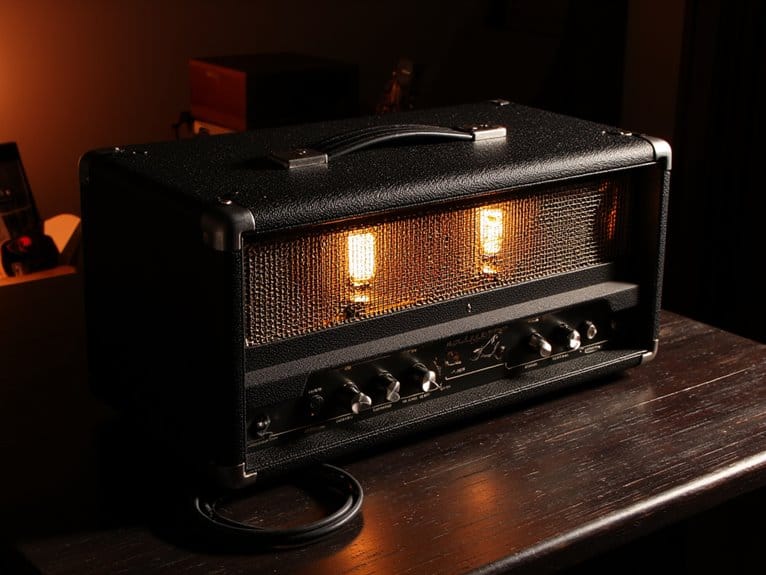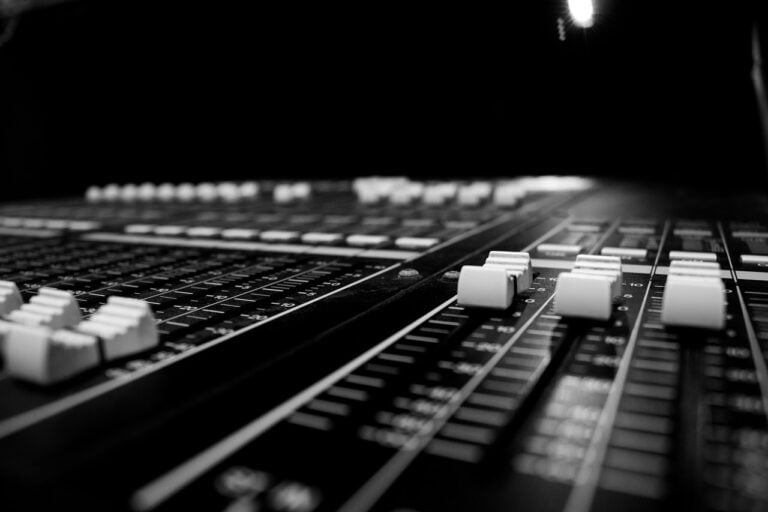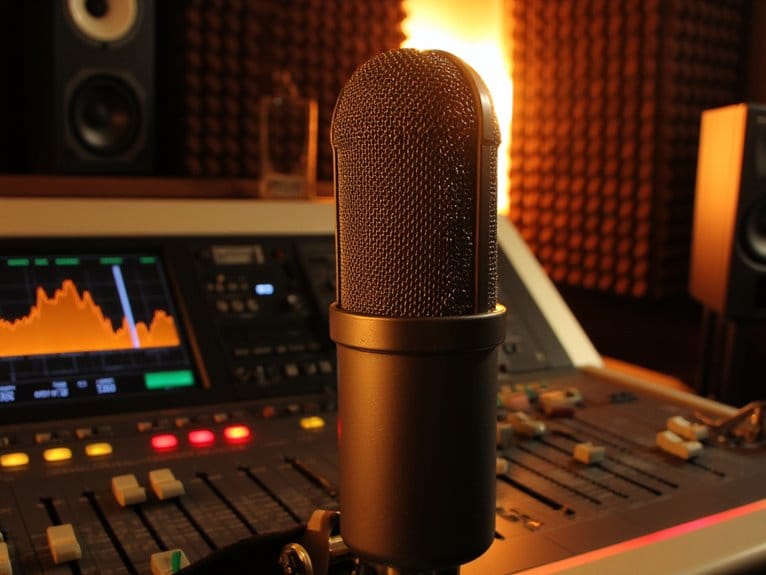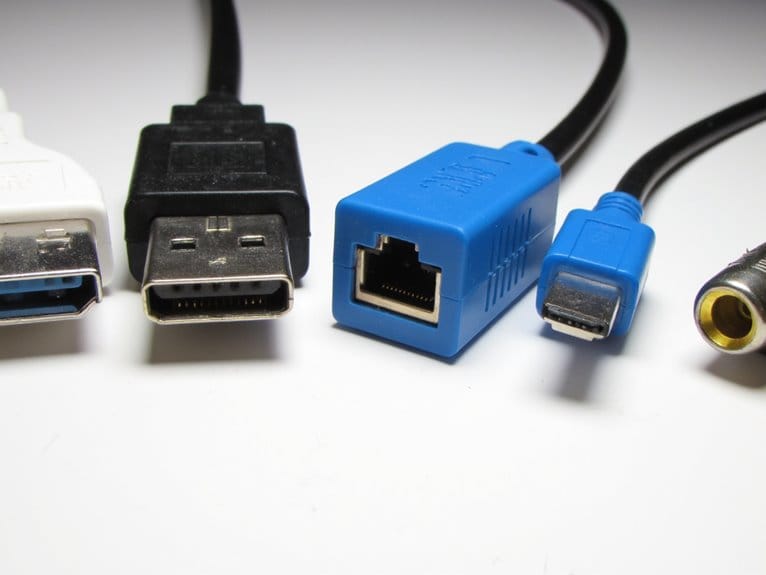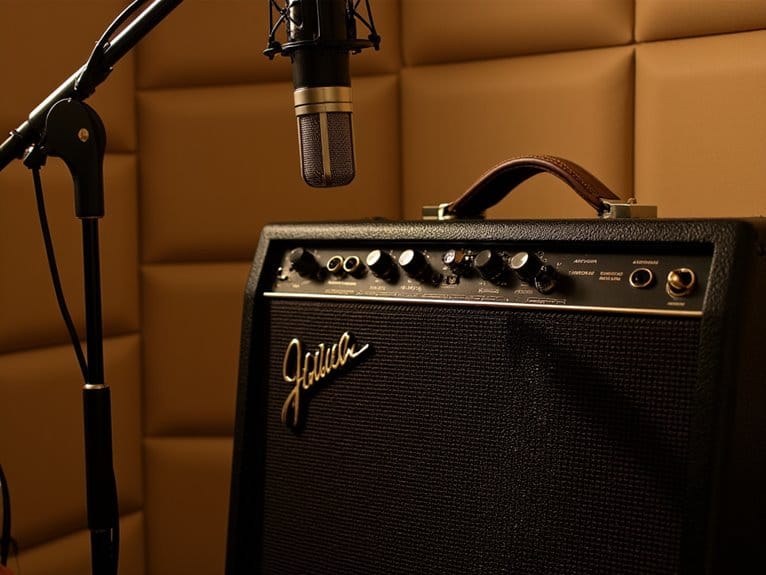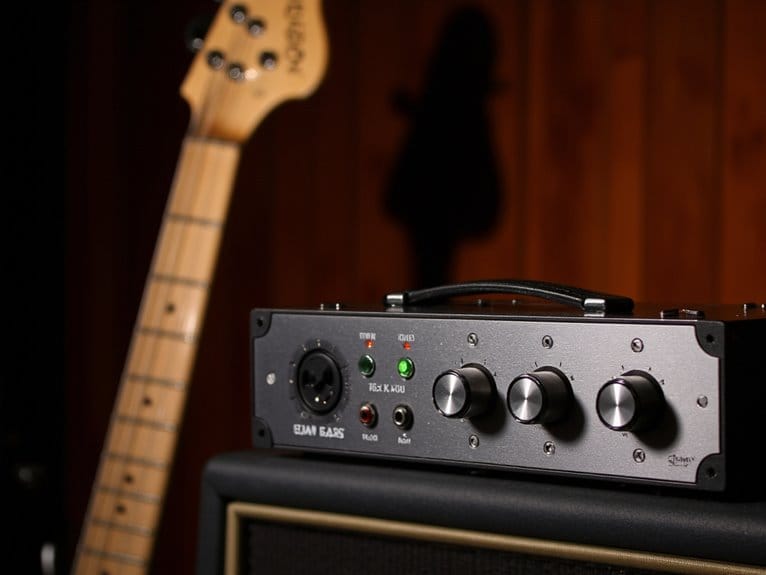Understanding Guitar Amplifier Wattage: Power Vs Volume Myths
Guitar amplifier wattage myths persist because you’ve been told doubling watts doubles volume, but human hearing works logarithmically—your 100-watt amp only sounds marginally louder than a 50-watt model, delivering just 3 decibels more output. You’d need roughly 500 watts to achieve truly double the perceived loudness from that 50-watt baseline. Speaker sensitivity, impedance matching, and amplifier design affect volume far more than raw wattage alone, making a high-efficiency speaker with fewer watts outperform low-sensitivity alternatives with markedly more power behind them.
We are supported by our audience. When you purchase through links on our site, we may earn an affiliate commission, at no extra cost for you. Learn more.
Notable Insights
- Doubling amplifier wattage only increases volume by 3 decibels, not double the perceived loudness.
- Achieving double perceived loudness requires approximately 10 times more wattage, not just doubling power.
- Speaker sensitivity significantly impacts volume output; high-sensitivity speakers can outperform higher-wattage, low-sensitivity combinations.
- Tube amplifiers typically sound louder than solid-state amps at the same wattage rating.
- Higher wattage doesn’t guarantee better sound quality; amplifier design and speaker efficiency matter more.
The Logarithmic Nature of Human Hearing and Amplifier Output
When you’re trying to understand why a 100-watt amplifier doesn’t sound twice as loud as a 50-watt amp, the answer lies in how our ears process sound—and I’ll admit, it’s not as straightforward as most of us would expect.
Your hearing operates on logarithmic perception, which means doubling the perceived volume actually requires roughly ten times more sound intensity. This explains why that 100-watt Marshall doesn’t blow your mind compared to its 50-watt counterpart—you’re only getting about 3 decibels more volume, which translates to a barely noticeable increase in loudness.
To achieve truly double the perceived volume, you’d need approximately 500 watts, making those massive power ratings less impressive than manufacturers would have you believe. Your ear’s sensitivity peaks around 3 kHz, which means certain frequencies will naturally sound louder than others even at identical power levels. Just like professional mixing boards maintain a signal-to-noise ratio above +90 dB for quality audio reproduction, amplifiers require precise engineering to deliver clean power across the full frequency spectrum. Understanding this geometric mean principle helps explain why finding the sweet spot for your amplifier’s output isn’t simply about splitting the difference between low and high settings.
Similar to how tracking accuracy affects the performance of modern guitar synth pedals, the precision of your amplifier’s power delivery directly influences the quality of your sound output.
Why Doubling Wattage Doesn’t Double Volume
The mathematics behind amplifier wattage reveals a counterintuitive truth that confounds many guitarists—doubling your amp’s power doesn’t deliver the dramatic volume boost you’d expect.
When you upgrade from a 50-watt to 100-watt amplifier, you’re only gaining approximately 3 dB in sound pressure level, which represents a noticeable but modest increase that falls far short of doubling perceived loudness.
These persistent wattage myths stem from our logarithmic hearing system, where volume perception requires exponential power increases to achieve linear loudness gains.
To actually sound twice as loud, you’d need roughly ten times the power, translating that 50-watt amp into a 500-watt behemoth.
Understanding this logarithmic relationship helps explain why experienced players often prioritize speaker efficiency and amplifier headroom over raw wattage numbers.
Speaker Sensitivity: The Hidden Factor in Amplifier Loudness
While amplifier wattage captures most guitarists’ attention, I’ve discovered that speaker sensitivity often plays a more dramatic role in determining how loud your rig actually sounds. Sensitivity ratings, measured in decibels at one watt and one meter, reveal how efficiently your speaker converts electrical power into acoustic output, and frankly, most players completely ignore this vital specification.
| Speaker Sensitivity | Power Requirements for 100 dB |
|---|---|
| 90 dB @ 1W/1m | 10 watts |
| 95 dB @ 1W/1m | 3.2 watts |
| 100 dB @ 1W/1m | 1 watt |
| 105 dB @ 1W/1m | 0.32 watts |
A high-sensitivity speaker paired with a modest amplifier often outperforms a low-sensitivity speaker driven by greatly more wattage, making sensitivity the hidden variable that determines your rig’s actual volume potential. The physical dimensions of your speaker also matter significantly, as 12-inch speakers deliver superior bass response and projection compared to smaller alternatives, which explains why they remain the gold standard for most combo amplifiers. Just as acoustic guitars benefit from solid wood construction for enhanced tonal quality, electric guitar amplifiers require careful attention to speaker specifications rather than focusing solely on wattage numbers.
Ohm Ratings and Impedance Matching for Safe Operation
How often have you connected speakers to your amp without giving impedance a second thought, only to wonder why your rig doesn’t sound quite right or why that warning about “minimum load” exists in your manual?
Understanding ohm ratings isn’t just technical jargon—it’s essential for safe operation and ideal tone. Your amp expects specific impedance loads, typically 4, 8, or 16 ohms, and mismatching can damage components or reduce performance.
Impedance matching protects your gear and ensures optimal tone—ignoring ohm ratings risks expensive damage and poor performance.
When connecting multiple cabinets, speaker wiring matters considerably; series connections add impedances together, while parallel wiring divides them. These impedance calculations determine whether you’re pushing your amp beyond safe limits or robbing it of power.
Proper matching guarantees maximum power transfer, protects your investment, and delivers the tone your amp was designed to produce.
Choosing the Right Wattage for Your Playing Environment
Now that you’ve got your impedance matching sorted out, let’s talk about something that’ll make or break your playing experience: choosing the right wattage for where you actually play.
For home practice, you’ll want low-wattage amps between 1-20 watts, with 5-15 watt tube amps delivering clean tones without disturbing neighbors. These smaller amps give you natural power-amp distortion at manageable volumes, which honestly sounds better than cranking a massive amp at bedroom levels.
When you move into rehearsal settings with drummers, you’ll need 20-45 watts for adequate headroom and volume competition.
Medium venues require 50-100 watts, while large outdoor performances demand 100+ watts to cut through the mix effectively.
Common Misconceptions About Power and Performance
You’ve probably heard guitarists claim that more watts automatically means louder sound, or that higher wattage guarantees better tone quality, but these widespread beliefs represent some of the most persistent myths in the amplifier world.
I’ve tested countless amps over the years, and the relationship between wattage and actual performance is far more complex than most players realize, with factors like speaker efficiency, amplifier design, and distortion characteristics playing equally significant roles.
The truth is that doubling your amp’s wattage only increases perceived volume by a small margin, while tone quality depends primarily on circuit design and component selection rather than raw power output. As many guitarists discover, speaker quality is equally crucial to achieving the desired tone, regardless of the amplifier’s power rating.
For home practice, amplifiers in the 5-20 watt range maintain excellent sound integrity while providing the clean tones and overdrive capabilities that guitarists need for musical exploration.
More Watts Equals Louder
When I first started playing guitar, I made the same mistake countless musicians make—I assumed that more watts automatically meant a louder amplifier, and I couldn’t have been more wrong about how power actually translates to volume.
The relationship between wattage and loudness isn’t linear, which surprised me when I discovered that doubling wattage doesn’t double perceived volume. Wattage efficiency depends heavily on amplifier characteristics, including tube versus solid-state design, speaker efficiency ratings, and impedance matching.
| Wattage Jump | Perceived Loudness Increase |
|---|---|
| 15W to 30W | Barely noticeable |
| 30W to 60W | Slight increase |
| 30W to 100W | Moderate increase |
| 30W to 300W | Significant increase |
| 30W to 600W | Double loudness |
You’ll find that a 20-watt tube amp can easily outperform a 100-watt solid-state amp in perceived loudness. Many modern amplifiers feature adjustable power output settings that allow you to achieve excellent tone at low volumes for home practice while maintaining adequate headroom for live performances. Higher wattage options maintain clarity, whereas lower wattage amps may distort under high pressure.
Wattage Determines Sound Quality
Despite what many guitarists believe, higher wattage doesn’t guarantee better sound quality—a misconception I held for years until I compared my friend’s 15-watt tube amp to my 100-watt solid-state head and realized his modest amp delivered richer, more satisfying tones.
This wattage myth crumbles when you understand that quality factors like amplifier type, circuit design, and speaker efficiency matter more than raw power numbers. Tube amps generate natural harmonic distortion and compression that enhances perceived warmth, while solid-state amps produce cleaner signals that can seem less vibrant.
Your amp’s sonic character depends on how components interact, not wattage alone, which explains why two 50-watt amplifiers can sound completely different despite identical power ratings. Similar to how tension control mechanisms vary between guitar capos despite similar designs, the internal engineering and materials determine the actual performance quality. However, higher wattage does provide cleaner and more defined tones when you need to cut through a full band mix during live performances.
On a final note
You’ll find that understanding amplifier wattage isn’t just about chasing bigger numbers, but rather grasping how power, speaker sensitivity, and impedance work together in your specific environment. Don’t fall for the common myth that doubling watts means doubling volume—your ears simply don’t work that way. Focus on matching your amp’s capabilities to your actual needs, whether you’re practicing at home or performing on stage.

